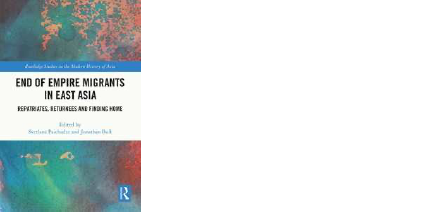本書は、1945年の大日本帝国崩壊後、東アジア地域で引揚げ移民となった約900万人の移動について学際的に研究するものである。日本政府の引揚政策と東アジアにおける人びとの引揚経験がどのように交錯していたかを、生の証言の収集と4つの主要テーマの検討を通じて明らかにする。第一のテーマは、歴史学と言説としての送還(引揚)で、第二次世界大戦後、日本では送還がどのように研究、議論、表現されてきたかを検証している。第二のテーマは、「旧帝国における故郷の発見」であり、目の前で国境が動いた時の旧植民地の人々の多様な経験を生の証言を通して明らかにする。
第三のテーマ「政府の政策」では、1950年代から1970年代にかけての日本政府の政策の変遷を探る。第四のテーマ「帰国後の統合」では、旧植民地出身者が帰国後、どのように日本社会に統合されていったかを明らかにする。
Introduction
Svetlana Paichadze and Jonathan Bull
Part 1: Repatriation in historiography, political discourse and the history of Indigenous Peoples
1. Japanese-language historiography about end of empire migration: revising the extruded history of repatriation and hikiagesha
Jonathan Bull
2. Hikiagesha and other terms for returnees in the minutes of the National Diet of Japan
Ayako Tominari
3. Travel, forced movement, ‘repatriation’: multiple mobilities in the history of the Indigenous Peoples of Sakhalin and the Kuril Islands
Tessa Morris-Suzuki
Part 2: Finding ‘home’ in the former Japanese Empire
4. The ‘repatriation’ of Japanese wives from Manchuria to Taiwan: a presence hidden by multiple factors
Yōhei Fujino
5. The social movement for Sakhalin Korean repatriation after the Second World War: the establishment of the Korean Communist party
Yulia Din
6. The ‘Remembered’ Sakhalin Koreans in the South Korean Press, 1946-1980
Kim Yehbohn Lacey
7. Between loving the country and loving the land: the case of waishengren and hwagyo
Hisahiko Kamizuru
Part 3: Repatriation policy and returning home in the 1950s-1960s
8. The boundary formation between ‘hikiage’ and ‘kikoku’: the case of the ‘honkoku kikansha’ from China
Makoto Minami (Liang Xue Jiang)
9. Individual multiethnic repatriation from the Soviet Union
Svetlana Paichadze
10. The ‘delayed "repatriation"’ of Japanese women in Korea: the beginning of the return policy in postwar Japan
Mooam Hyun
Part 4: Repatriation and integration: life after hikiage
11. Industry-induced movements of people and connections among repatriates from the Karafuto coal industry
Takefumi Hirai
12. The socioeconomic reintegration of repatriates: evidence from Gifu prefecture
Steven Ivings
13. An anthropology of nostalgia: wansei’s postwar life and their Taiwan recognition
Yu Nai Hui
14. Border, Indigenous Peoples, self-identification: contested memory as seen in the social activities of Ainu, Uilta and Nivkh
Svetlana Paichadze and Jeffry Gayman



